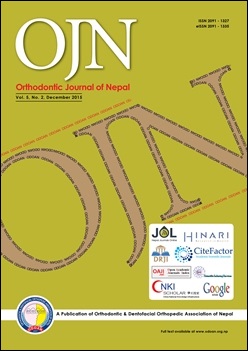Shear Bond Strength of Ceramic Brackets with Different Base Designs: An in-vitro Study
DOI:
https://doi.org/10.3126/ojn.v5i2.15220Keywords:
adhesive bracket-base interface, adhesive remnant index, microcrystalline base, shear bond strengthAbstract
Objective: To evaluate the influence of bracket base designs on shear bond strength of ceramic brackets bonded to natural teeth and to determine the common site of bond failure.
Materials & Method: 120 therapeutically extracted maxillary first premolars were divided into six groups of 20 samples each and were mounted in resin blocks. Each sample was bonded with bracket of that particular group and subjected to thermocycling. The shear bond strength was measured using Universal Testing Machine. After debonding, the teeth and brackets were examined under stereo-microscope for adhesive remnant index.
Result: Ceramic brackets with ball base design (Group A) yielded statistically highest shear bond strength followed by microcrystalline base (Group D), dimple base (Group E), mesh base (Group C) and dove tail base (Group B) design. Ceramic brackets yield higher bond strength than metal brackets (Group F) irrespective of base design. Insignificant difference was seen between Group A and Group D and between Group B and Group C. Bond failure between adhesive and bracket (Type 3) was seen in 80% of the brackets with ball base design and bond failure between adhesive and bracket (Type 1) was seen in 80% of brackets with dove tail base design.
Conclusion: Bracket base design is an important consideration for shear bond strength. Base design with more number of undercuts offer higher shear bond strength. Ceramic brackets with more number of mechanical undercuts were less likely to bond failure at adhesive bracket base interface and vice versa
Downloads
Downloads
Published
How to Cite
Issue
Section
License
Copyright © held by Orthodontic & Dentofacial Orthopedic Association of Nepal
- Copyright on any research article is transferred in full to the Orthodontic & Dentofacial Orthopedic Association of Nepal upon publication in the journal. The copyright transfer includes the right to reproduce and distribute the article in any form of reproduction (printing, electronic media or any other form).
- Articles in the Orthodontic Journal of Nepal are Open Access articles published under the Creative Commons CC BY License (https://creativecommons.org/licenses/by/4.0/)
- This license permits use, distribution and reproduction in any medium, provided the original work is properly cited.




